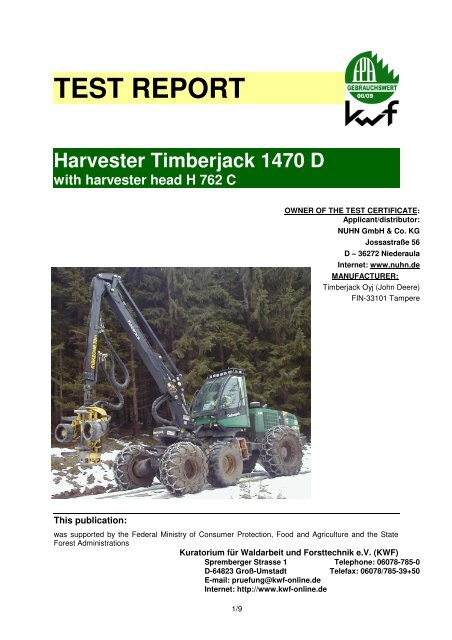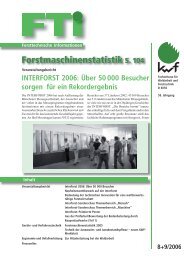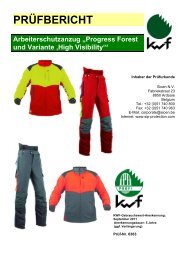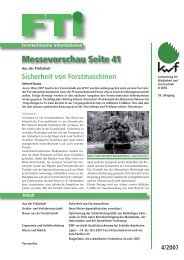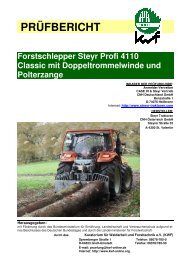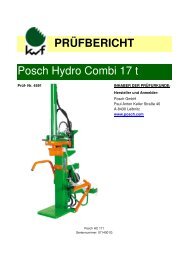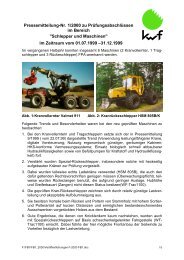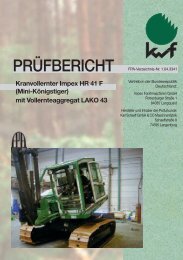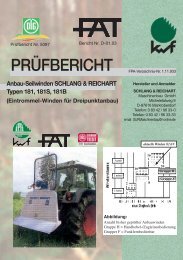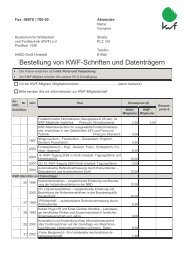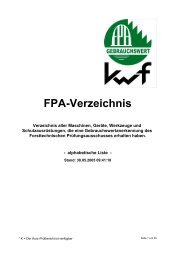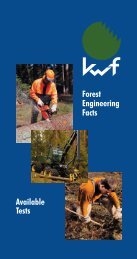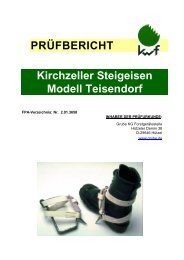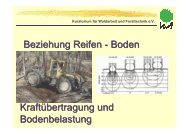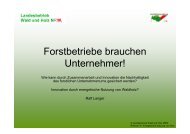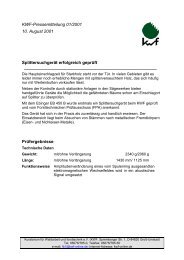TEST REPORT
TEST REPORT
TEST REPORT
You also want an ePaper? Increase the reach of your titles
YUMPU automatically turns print PDFs into web optimized ePapers that Google loves.
<strong>TEST</strong> <strong>REPORT</strong><br />
Harvester Timberjack 1470 D<br />
with harvester head H 762 C<br />
OWNER OF THE <strong>TEST</strong> CERTIFICATE:<br />
Applicant/distributor:<br />
NUHN GmbH & Co. KG<br />
Jossastraße 56<br />
D – 36272 Niederaula<br />
Internet: www.nuhn.de<br />
MANUFACTURER:<br />
Timberjack Oyj (John Deere)<br />
FIN-33101 Tampere<br />
This publication:<br />
was supported by the Federal Ministry of Consumer Protection, Food and Agriculture and the State<br />
Forest Administrations<br />
Kuratorium für Waldarbeit und Forsttechnik e.V. (KWF)<br />
Spremberger Strasse 1 Telephone: 06078-785-0<br />
D-64823 Groß-Umstadt Telefax: 06078/785-39+50<br />
E-mail: pruefung@kwf-online.de<br />
Internet: http://www.kwf-online.de<br />
1/9
Harvester Timberjack 1470 D<br />
with harvester head H 762 C<br />
Evaluation– Review<br />
Test item Test results Evaluation<br />
Harvester class 3<br />
Chief application field<br />
Driving performance<br />
Engine power > 140 kW<br />
Clearing coniferous forest, average chest height diameter of trunks 25 – 40 cm; maximum<br />
trunk diameter 59 cm<br />
satisfactory<br />
Driving speed Off-road 7.3 km/h; road 19.7 km/h - / + +<br />
Off-road capability Off-road capability coefficient: 0.81 o<br />
Transport Overall transport height on special flat bed trailer > 4.10 m - -<br />
Felling and processing<br />
Crane control<br />
Electronic transmission system Timbermatic 300 TMC,<br />
7 programmable operator settings<br />
good<br />
+ +<br />
Crane construction Net lifting power 178 kNm, 9.7 m reach +<br />
Stability Lateral stability when loaded at maximum reach is provided (with water) o<br />
Delimbing Feed speed 4.2 m/s, feed force 29.5 kN +<br />
Directed felling +<br />
Measuring and control system Timberjack Timbermatic 300 +<br />
Ergonomics<br />
Very good<br />
Noise L eq = 60 dB(A) + +<br />
Vibration K = 5.77 + +<br />
Cab design Very well arranged display and control elements + +<br />
Attenuating forces Very low + +<br />
Visibility High convex windscreen, narrow cab stays +<br />
Workspace illumination On the whole good and glare-free illumination o<br />
Work safety<br />
DPLF work safety test<br />
Environmental safety high minimum tyre pressure 240 – 550 kPa satisfactory<br />
Ground impact 48 ground impact points - -<br />
Operational fluids Rapid bio-degradable hydraulic fluid, no RME capability +<br />
Fuel consumption 13 - 15 l/ operating hr (spec. consumption 194 g/kWh) + + / +<br />
Leak reduction design<br />
measures<br />
Vacuum pump, electric fill pump + +<br />
Emissions Complies with EU guideline 97/68 EG level 2 o<br />
Economy<br />
Cost (without wages)<br />
Maintenance (incl. refuelling)<br />
Power<br />
According to calculation scheme 106 Euro/ operating hour<br />
(based on 1500 operating hours/year)<br />
approx. ½ hour daily; approx. 1 hour weekly<br />
Within power limits for this harvester class<br />
Distinctive features<br />
+ + = very good; + = good; o = satisfactory; - adequate; - - = inadequate (*Manufacturers declaration)<br />
2/9
Short description<br />
Figure 1: Machine sketch and crane area diagram<br />
• Front and rear bogie in closed frame construction<br />
• decentralised articulated joint, interleaving joint with hydraulic interleaving joint brake (disc brake calliper on<br />
disc segment)<br />
• hydrostatic transmission with 1 locked maximum speed level, successive 2-step group transmission (stand<br />
only control, with locked operational brakes) and power divider; permanent front bogie drive at low speeds,<br />
may be switched on at higher speeds<br />
• Test tyres: front: Trelleborg LS2 428 650/60-26,5 20 PR<br />
rear: Nokian TRS-LS2 700/70-34 16 PR<br />
• Multi-circuit hydraulic system for drive and work circuit with joint oil supply for drive and work equipment;<br />
main units: harvester head, brake, steering, hydrostat, drive control, crane and cab control and actuators<br />
• Electronic transmission system for crane functions and machine control (Timberjack TMC together with<br />
Timbermatic 300)<br />
• Total weight (incl. water):<br />
• Transport height for flat bed trailer:<br />
for road:<br />
23840 kg<br />
3850 mm<br />
4235 mm<br />
• Width (maximum):<br />
• Turning circle diameter:<br />
2984 mm<br />
14300 mm<br />
• Chief application field<br />
Depending on the conditions of the terrain (micro-relief, obstructions, snow) the machine cannot be operated<br />
above a gradient of about 30%. The application field is also determined by the maximum felling diameter (59<br />
cm) and the maximum delimbing diameter of 45 cm. The machine is capable of processing long wood as<br />
well as hardwood.<br />
Min.<br />
Akt.<br />
Max.<br />
Gross lifting moment (kNm)<br />
130,0<br />
178,0<br />
220,0<br />
0 50 100 150 200 250<br />
Figure 2: Comparison between the current test machine and the minimum and<br />
maximum values from the 8 machines tested to date in the same engine power class.<br />
3/9
Engine<br />
Liquid-cooled 6 cylinder diesel engine JD 6081 HTJ 04 with direct injection and common-rail water-cooled turbo<br />
charger and air-cooled intercooling<br />
Capacity 8100 cm³<br />
Power Nominal engine speed 2200 1/min 180 kW<br />
max. torque Nominal engine speed 2200 1/min 810 Nm<br />
max. torque working engine speed 1500 1/min 1095 Nm<br />
Torque increase 35.0 %<br />
Average fuel consumption under working conditions 14 l/operating<br />
hour<br />
Fuel tank capacity 480 l<br />
rapeseed oil methyl ester or vegetable oil capability<br />
no<br />
Engine power (kW)<br />
Min.<br />
145,0<br />
Akt.<br />
180,0<br />
Max.<br />
181,0<br />
0 50 100 150 200<br />
Figure 3: Comparison between the current test machine and the minimum and<br />
maximum values from the 8 machines tested to date in the same engine power class.<br />
Min.<br />
Fuel consumption (l/operating hour)<br />
Akt.<br />
Max.<br />
11,3<br />
14,0<br />
18,0<br />
0 5 10 15 20<br />
Figure 4: Comparison between the current test machine and the minimum and<br />
maximum values from the 8 machines tested to date in the same engine power class.<br />
Work circuit hydraulics<br />
Load sensing hydraulic system with permanent pressure; joint oil supply for work and drive circuit and an adjustable<br />
piston pump<br />
Hydraulic pump<br />
Mannesmann Rexroth A 11 VO<br />
Capacity At nominal engine speed (1600 rpm) 0 – 304 l/min<br />
Power output<br />
(installed power)<br />
at 2200 rpm<br />
at 1600 rpm<br />
195<br />
142<br />
kW<br />
kW<br />
Hydraulic pressure maximum 28 MPa<br />
Hydraulic tank capacity 300 l<br />
4/9
Drive circuit hydraulics<br />
Electronically controlled hydrostatic transmission<br />
Hydraulic pump<br />
Capacity<br />
Power output<br />
(installed power)<br />
Rexroth AA4VG125<br />
At nominal engine speed<br />
(2200 1/min)<br />
at 2200 U/min<br />
at 1600 U/min<br />
0 – 275 l/min<br />
Hydraulic pressure maximum 45,0 MPa<br />
Hydraulic engine<br />
Bosch Rexroth A6VM<br />
Absorption volume 0 - 160 cm³/U<br />
206<br />
150<br />
kW<br />
kW<br />
Crane<br />
TJ 210 H 97; mounted on front bogie; slewing mechanism centrally mounted between front axle; slewing mechanism<br />
driven by 4 pressure cylinders and 2 racks; parallel crane with boom and jib with a very low column and single-step<br />
telescope<br />
Gross lifting torque 178 Nm<br />
Tilt angle front/back/left/right 29 / 11 / – / – °<br />
Maximum reach (incl.1-step telescope) 9.7 m<br />
Net lifting power (maximum reach/4m reach) 1.8 / 36 kN<br />
Telescope pulling power 26.0 kN<br />
Slewing torque (left/right) 57.6 kNm<br />
Turning area (left/right) 219<br />
Required amount of hydraulic fluid * n.a. l/min<br />
*Manufacturers declaration<br />
°<br />
Min.<br />
Akt.<br />
Max.<br />
Maximum crane reach (m)<br />
9,3<br />
9,7<br />
10,1<br />
0 2 4 6 8 10 12<br />
Figure 5: Comparison between the current test machine and the minimum and<br />
maximum values from the 8 machines tested to date in the same engine power class.<br />
Measuring system evaluated according to the KWF-specification sheet<br />
Timbermatic 300<br />
Hardware<br />
Display<br />
Input device<br />
Colour VGA graphic display in work direction, mounted directly in front of operator (may obstruct<br />
view downhill), manual brightness and contrast control, excellent readability<br />
Keypad near joysticks (special keys for species and qualities), PC keyboard slides under<br />
monitor, trackball for controlling cursor; well proportioned and arranged for easy operation<br />
Printer Ink jet printer with single sheet printout (DIN A4)<br />
Control prints<br />
Data completeness<br />
Clarity of data labelling<br />
HKS-conformity<br />
Requirements of KWF-specification sheet<br />
Operability and performance of system<br />
Calibration and control of electronic callipers/manual<br />
Precision of measurement<br />
Measurement stability<br />
Overall evaluation:<br />
5/9<br />
yes<br />
satisfactory<br />
fulfilled<br />
Very good/satisfactory<br />
Very good<br />
Very good<br />
good
Harvester head<br />
H 762 C<br />
Overall mass<br />
1327 / 1270 kg<br />
(with/without rotator and swing brake)*<br />
required pump capacity* 220 l/min<br />
Cutting length(available) 700 mm<br />
Chain speed 40 m/s<br />
Saw chain lubricating oil consumption* n.a. l/operating hour<br />
Saw chain lubricating oil tank volume 5 l<br />
Feed roller diameter 480 mm<br />
Guide length 1210 mm<br />
Delimbing diameter 450 mm<br />
max. felling diameter 590 mm<br />
Arm function<br />
2 encircling delimbing knives at top and bottom of the unit; supported by feed rollers<br />
in necessary<br />
* Manufacturers declaration<br />
1 1 fixed top v-shaped delimbing knife<br />
2 2 top, encircling, moving delimbing knives attached to basic<br />
frame, diameter-dependant contact pressure<br />
3 2 swivelling hydrostatically driven feed rollers (steel rollers with<br />
elliptical spikes)<br />
4 2 lower movable delimbing knives<br />
5 Felling unit with electro-hydraulically operated and driven<br />
chainsaw, diameter-dependant cut control<br />
Figure 6 harvester head<br />
6 Spring-loaded length measuring wheel<br />
7 Diameter measurement by single angle gauge connected to<br />
control bar of the swivelling feed rollers (s. 4)<br />
8 Hydraulic chain tensioner<br />
Min.<br />
Akt.<br />
Max.<br />
Maximum felling diameter (cm)<br />
45,0<br />
59,0<br />
65,0<br />
0 10 20 30 40 50 60 70<br />
Figure 7: Comparison between the current test machine and the minimum and<br />
maximum values from the 8 machines tested to date in the same engine power class.<br />
6/9
Spare parts supply, manuals and service<br />
good<br />
Maintenance effort<br />
Maintenance scope<br />
Operator manual<br />
Spare parts list<br />
Satisfactory (checking engine oil level very uncomfortable, 2 people are required to close floor<br />
pan, there is no ladder or platform for changing lamps in the roof lighting array; except in<br />
these cases maintenance is easy, central lubrication of the boom facilitates crane<br />
maintenance; hydraulic tank drainage hose is difficult to locate); front lower maintenance<br />
covers must be opened with utmost caution<br />
According to schedule and need; time required for daily maintenance (incl. operational fluid<br />
refilling) is about ½ hour, weekly maintenance requires about 1 hour<br />
Very well structured, clear and easy-to-read instructions<br />
Profusely illustrated and well-structured; all parts are easily found<br />
Training Training provided at delivery and additional training is available upon request; 2 days and 1<br />
day additional training<br />
Cab<br />
Comfortable ROPS-, FOPS- and OPS – tested, vibration dampened, large safety cab, capable of swivelling sideways<br />
through 60°; large front screen; very organized design and good workmanship<br />
Operator seat<br />
Grammer Actimo XXL heated comfortable swivelling seat with air suspension,<br />
pneumatic brakes and longitudinal and transverse suspension; provided with a<br />
pneumatic lumbar support<br />
Comments / Evaluation<br />
Complies with<br />
standard<br />
Cab size and design<br />
Spacious cab with plenty of free space; ergonomic bright<br />
workplace; good workmanship; high front screen provides<br />
excellent upward visibility; good entrance<br />
yes<br />
Cab climate<br />
Efficient ventilation, heating and cooling; ventilator relatively loud at level 2 and above<br />
Control elements<br />
useful and well organized arrangement, all elements are well<br />
labelled and easy to reach<br />
yes<br />
Levelling Front and rear 12°, left and right 17°<br />
Work field illumination<br />
Visibility<br />
Overall good illumination of all work fields, especially of the harvester head, however,<br />
illumination of the area to the side of the crane column is less than adequate; there is no<br />
is no safe ladder or platform provided for maintenance work on the roof lighting array<br />
Large windows in the cab, which swivels with the crane, and a raised seating position<br />
provide good visibility; front visibility is obstructed by the crane cylinder and the display<br />
(blind area angle due to crane column 17.6°). High and convex front window provides<br />
excellent upward visibility (of the tree crowns)<br />
Noise low Noise level 60.0 dB(A) yes<br />
Vibration K eq = 5.8<br />
According to current state of knowledge, exposing the operator to these vibration levels<br />
for a period of 8 hours (shift) is not expected to have detrimental health effects.<br />
Storage space on the<br />
machine<br />
Storage space in the cab<br />
Adequate, 201 litres; 1 large volume storage space for tools and oil-binding materials in<br />
the front of the machine, 3 narrow but large spaces (somewhat inconveniently shaped)<br />
for hoses located in the frame and beneath the cab; storage space for cutting bars<br />
under the cab floor; usability of the front main storage space is good; other storage<br />
spaces can only be used for hoses and cutting bars; there is no exterior storage space<br />
for saw chains<br />
The cab contains many, very good lockable storage spaces; a special storage space is<br />
provided for the operating manual and first-aid kit<br />
7/9
Machine costs and calculation basis<br />
Price for tested version 365000 €<br />
Workload operating hours/year 1200 1500 2000 Total service life [operating hours] 10000<br />
Recovery period (years) 10 8 6 Repair cost factor 1.0<br />
€/<br />
operating<br />
hours<br />
(rounded)<br />
€<br />
/operating<br />
hours<br />
(rounded)<br />
€/<br />
operating<br />
hours<br />
(rounded)<br />
Fuel + lubricants in €/ operating hours 18.20<br />
Recovery 36.50 36.50 36.50 Price for diesel [€/l] 1.0<br />
Repair and maintenance 36.50 36.50 36.50 Interest rate [%] 8,0<br />
Fuel and lubricants 18.20 18.20 18.20 Transport costs [€]/1000 operating<br />
hours<br />
4500<br />
Interest rate 12.20 9.70 7.30 Additional costs [€] 7500<br />
Transport, driving 4.50 4.50 4.50 Technical work productivity:<br />
Others 6.30 5.00 3.80 13.5 cubic meters/operating hour<br />
Machine costs 113.50 109.70 106.10 Within the performance range for harvester class 3<br />
Additional equipment (not tested)<br />
none<br />
Test<br />
Note: Since this machine is no longer in production, the following additional requirements<br />
cannot be integrated by the manufacturer. However the manufacturer has incorporated the<br />
requirements and recommendations into the design of the follow-up series of the machine<br />
Remaining requirements:<br />
The values for axle loads, permitted total weight as well as maximum permitted axle loads during operation<br />
contained in the TÜV report must be aligned with the measured values.<br />
The machine must be provided with a hose list to enable professional hydraulic service engineers to construct<br />
the necessary hoses for the machine.<br />
The metal grid, which forms the maintenance platform, becomes soiled with wood chippings and soil during<br />
operation. This grid is difficult to clean.<br />
There is no suitable ladder and handgrips or a non-slip platform provided for changing the lamps of the cab roof<br />
lighting array.<br />
All areas where hydraulic hoses chafe along the boom and jib of the crane and the decentralised articulated joint<br />
should be removed.<br />
Machine nominal power should be given in kW.<br />
The risk of losing the grub screw of the steering lever must be removed.<br />
The lower front and lower middle maintenance covers have no hinges. The opening width is unrestricted.<br />
Opening the covers can be very dangerous. The covers must be designed according to current applicable safety<br />
requirements.<br />
Instructions for driving on frozen bodies of water must be removed from the operating manual – alternatively it<br />
should contain a warning prohibiting the operation of the vehicle on frozen bodies of water.<br />
All entries not translated into German must be corrected.<br />
The instructions concerning the response to touching electrical power lines do not correspond to current accident<br />
prevention guidelines of the agricultural workers association (VSG 1.4, § 4) among others.<br />
The operating manual must include values for noise levels, whole-body and hand-arm vibration.<br />
8/9
There is no information concerning the choice of hydraulic fluids in the operating manual.<br />
Some maintenance points are only inadequately described in the instruction manual – this should be amended<br />
Recommendations:<br />
The crane tilt angle should be increased.<br />
The illumination of the lateral and rear work field should be improved. The switches for any necessary additional<br />
lamps (in this case from the motor hood to the back) should be in the cab.<br />
All maintenance instructions should be summarised in a maintenance and lubrication plan.<br />
Possibilities for reducing transport height should be considered<br />
Controlling oil level and filling engine oil requires the operator to adopt an awkward posture – this should be<br />
improved.<br />
The steering properties of the machine on the road should be improved.<br />
In some instances, the printouts are difficult to understand because of the lack of clear labelling<br />
The following documents were not available:<br />
Proof of compliance with regulations concerning pressurized storage tanks (e.g. manufacturer certificate<br />
according to TRB 521/522)<br />
Certification concerning the flammability of the cab interior according to ISO 3795<br />
Test institute<br />
Kuratorium für Waldarbeit und Forsttechnik, Groß-Umstadt<br />
Authors<br />
Dr. Günther Weise, Lars Nick, Dr. Andreas Forbrig, KWF, Groß-Umstadt<br />
KWF-Utility-Test<br />
Test no. 3683, valid until June 30, 2014<br />
According to the test regulations, the applicant is entitled to display the test mark on machines of this<br />
type and to use the certification for advertising purposes.<br />
9/9


